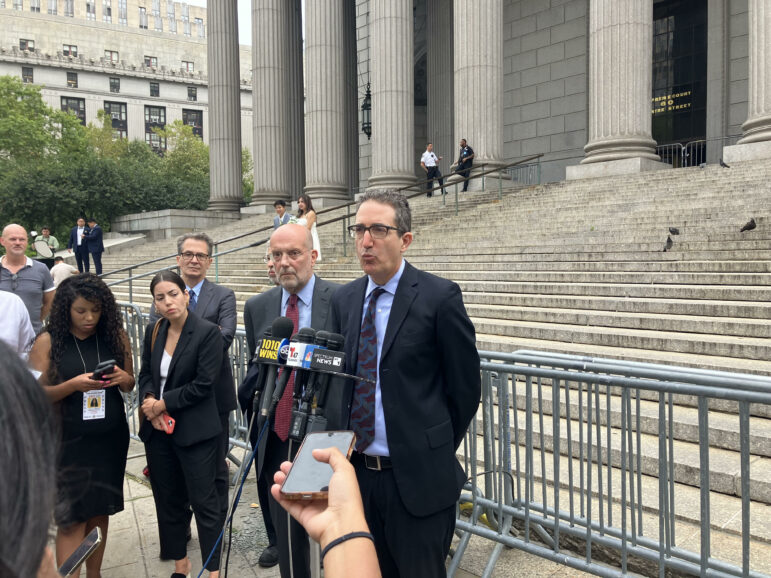Following a closed-door conference Friday, the Legal Aid Society urged the state to step up its efforts to protect the right to shelter in New York City, where tens of thousands of migrants have arrived since last year.

For the second time in less than a month, lawyers gathered behind closed doors in a Manhattan courtroom Friday to discuss the fate of a set of rules that have defined New York City’s response to homelessness for decades.
In short, the city is obligated to provide a shelter bed to anyone in need—part of a unique set of rules that grew from a 1981 consent decree in the lawsuit Callahan v. Carey, establishing a right to shelter for single men.
But until Thursday morning, asylum seekers had cued up for days outside of the Roosevelt Hotel in Midtown Manhattan, a designated intake center, unable to gain entry. They were among tens of thousands of migrants who have arrived in New York City since last year, pushing the city’s overall shelter population north of 100,000.
“What we saw this week was a clear violation of the law in New York,” Josh Goldfein, a staff attorney at the Legal Aid Society’s Homeless Rights Project, told reporters Friday.
The Roosevelt log jam prompted the Legal Aid Society, tasked with enforcing the right to shelter, to demand an emergency court conference. The parties first convened in July, after Mayor Eric Adams sought permission to pause shelter obligations for single adults in instances where the city lacks necessary resources.
But after nearly an hour of private negotiations Friday, the state—which has obligations under Callahan, in addition to the city—had landed in the hot seat.
City officials will prepare a proposal for the state by Aug. 9 laying out their needs, Supreme Court Judge Erika M. Edwards said, adding that these needs are “not monetary only.” The state will have a chance to respond, and the parties will return to court on Aug. 16.
At a press gaggle outside of the courthouse, Goldfein of Legal Aid said Judge Edwards had urged the state to step up during Friday’s conference.
“The court was trying to light that fire, to impress upon the state that they need to take this seriously, they need to respond urgently, they need to move quickly, in order to avoid a repeat of scenes like what we saw this week,” he said.
Gov. Kathy Hochul could issue an executive order to prevent localities from trying to block new arrivals from being sheltered in their communities, something several counties have done, Goldfein said. The state could also offer additional funding and more shelter sites and labor support.
So far, the state has identified three sites for asylum seekers—the former Lincoln Correctional Facility in Manhattan and a hangar at JFK Airport, both of which opened in June, plus the Creedmoor Psychiatric Center in Queens, set to open this month. The city has opened 194 shelter sites, including 13 humanitarian relief centers.
A representative for the governor declined to comment on pending litigation, but pointed City Limits to Hochul’s comments at an Aug. 1 press conference. At the time, she referenced $1 billion in funding to support asylum seekers in her latest budget, including $700 million for shelter costs and $160 million for support from the National Guard.
“They literally go out and buy the baby food and help build the cribs and provide security,” Hochul said.
The governor added that she is lobbying the federal government to loosen work authorization requirements for migrants who are desperate for jobs—something Mayor Adams has also called for. “I can’t stand here at this time and say it’s successful, but they absolutely know that is what the Governor of New York wants,” she said.
Theodore Moore, vice president of policy and programs at the New York Immigration Coalition, said Friday that he has noticed a lot of finger pointing between the city, state and federal government in response to the influx of migrants to New York City.
“Right now it’s like the Spider-Man meme,” he said, referencing the viral image of three versions of the cartoon superhero pointing at each other.
But Moore said the governor could do more to discourage xenophobia around the state. In June, New York City sued 30 counties for rejecting migrants.
“The Hochul administration should be doing a lot more to push back against these county executives,” Moore said.
In a statement following Friday’s court hearing, Mayor Adams reiterated calls for help. “As we’ve known since the early days of this crisis, this is not just a New York City emergency, but a crisis that requires support from the state and federal governments,” he said.
By Thursday of this week, the city had managed to bring everyone lined up outside the Roosevelt Hotel indoors, according to Goldfein of Legal Aid. But he noted that the city could not guarantee that a similar situation will not occur in the future.
“If it does, we will have to come back here and see the judge again, to make sure that people’s rights are protected and that they have a safe place to be inside,” he said.









2 thoughts on “‘A Clear Violation of the Law’: Shelter Strain Sends City and State Back to Court”
What kind of mess is this. Go Figure!
Longtime residents of New York that have worked and lived in the city are being evicted and displayed from their communities because of greed and gentrification.